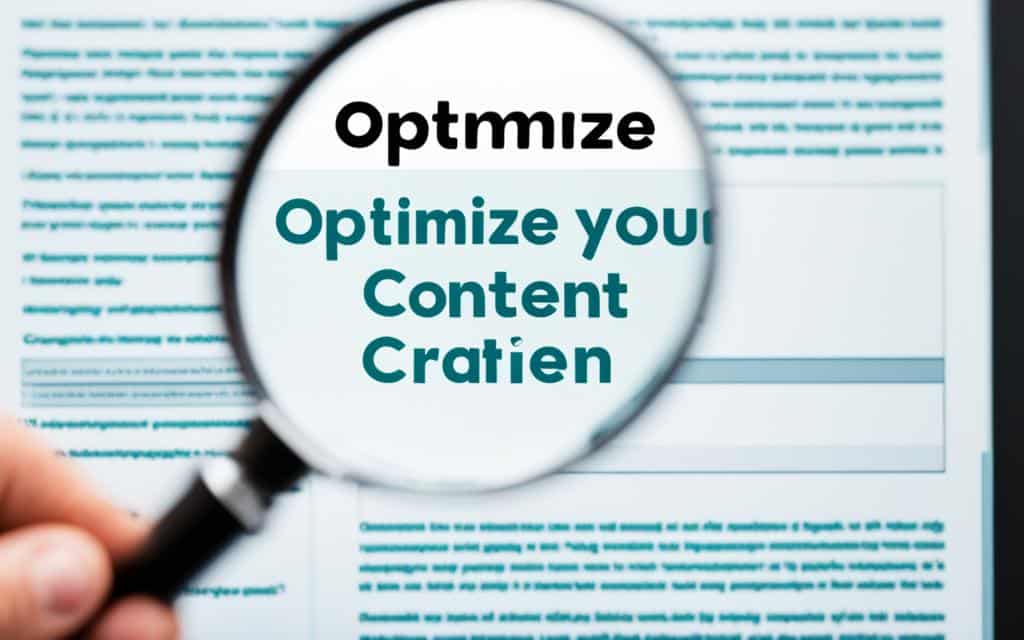Table of Contents
Optimising your blog content is crucial for increasing engagement and improving your blog’s success. By implementing strategic techniques, you can enhance your blog’s visibility and attract more organic traffic.
In this article, we will explore various strategies to optimise your blog content and boost reader engagement. You will learn how to craft attention-grabbing headlines with relevant keywords, choose engaging images to enhance visual appeal, structure your content with subheadings for easy navigation, write compelling introductions to hook readers, and more.
With the growing importance of blog content engagement, it is essential to optimise your content to stand out in the crowded digital space. By following these best practices and leveraging search engine optimization, you can create better engagement, attract a larger audience, and achieve your blogging goals.
Crafting Attention-Grabbing Headlines with Relevant Keywords
Captivating headlines play a crucial role in capturing the reader’s interest and enticing them to click on your blog post. An attention-grabbing headline hooks your audience and compels them to read further. Crafting such headlines requires a strategic approach that combines creativity, relevance, and optimization.
One effective way to optimize your headlines is by incorporating relevant keywords. By including keywords that align with the content of your blog post, you can improve your search engine visibility and attract readers who are actively searching for information related to your topic.
Additionally, analyzing data from previous posts and conducting competitor analysis can provide valuable insights into what resonates with your target audience. By understanding the preferences and expectations of your readers, you can create compelling titles that drive engagement.
Remember, your headline is the first impression readers have of your blog post. Therefore, it is crucial to make it captivating, informative, and relevant to entice readers to click and explore further.
With the right mix of creativity, keyword optimization, and audience understanding, you can craft attention-grabbing headlines that elevate the success of your blog posts.
Emphasize the importance of creating attention-grabbing headlines that incorporate relevant keywords to optimize your blog post titles and engage your audience.
Choosing Engaging Images to Enhance Visual Appeal
Images play a crucial role in enhancing the visual appeal and user experience of your blog posts. By selecting visually relevant images that align with your brand, you can evoke emotions and create a more memorable experience for readers.
Studies have shown that blog posts with relevant images have higher conversion rates. When users are presented with engaging visuals, they are more likely to spend more time on your blog, explore further, and take the desired actions.
To choose engaging images, consider the following:
- Relevance: Select images that are directly related to your blog post’s topic or message. This ensures that the visuals supplement and support the written content, enhancing its overall impact.
- Aesthetics: Opt for visually appealing images that are high-quality, well-composed, and visually balanced. Remember that the goal is to captivate your readers and create a pleasant viewing experience.
- Emotional appeal: Images have the power to evoke emotions and influence how readers perceive your content. Choose visuals that elicit the desired emotions and align with the tone and message of your blog post.
- Brand alignment: Ensure that the chosen images align with your brand’s visual identity and values. Consistency in imagery strengthens brand recognition and helps readers associate the content with your brand.
Once you’ve selected the right images, optimize their file sizes to ensure fast page loading speeds. Large image files can slow down your website, negatively impacting user experience and increasing bounce rates. Remember to always follow copyright laws and use proper attribution when using images sourced from external platforms.
Enhancing your blog posts with engaging images not only improves the visual appeal but also creates a more immersive and enjoyable user experience. The right visuals can spark curiosity, convey information effectively, and ensure that your content stands out from the crowd.
Benefits of Using Engaging Images
| Benefits | Description |
|---|---|
| Increased engagement | Engaging images capture readers’ attention and encourage them to interact with your blog post, leading to higher engagement levels. |
| Improved comprehension | Visuals complement written content and help readers better understand complex concepts or instructions. |
| Enhanced shareability | Appealing images are more likely to be shared on social media platforms, expanding your blog’s reach and driving more traffic. |
| Increased brand recognition | Consistent use of brand-aligned images strengthens brand identity, helping readers recognize and associate your content with your brand. |
| Improved search engine optimization | Using relevant images can improve your blog’s visibility in image search results and enhance your overall SEO efforts. |
When it comes to optimizing your blog content for better engagement, the structure of your content plays a vital role. By utilizing subheadings effectively, you can improve reader engagement and enhance search engine visibility.
Subheadings serve as signposts that break down your content into smaller, digestible sections. They not only make it easier for readers to navigate through your blog post but also help search engine crawlers understand the context and hierarchy of your content. When search engines can easily analyze and interpret your content, your chances of ranking higher in search results improve significantly.
Using Subheadings Strategically
When structuring your blog post with subheadings, it’s important to use them strategically to enhance the overall experience for your readers.
- Organize your content logically: Group related information together under relevant subheadings. This makes it easier for readers to find the specific information they’re looking for and encourages them to stay on your page longer.
- Highlight key points and takeaways: Use subheadings to draw attention to important points and takeaways. This not only aids in easy skim reading but also helps readers quickly grasp the main highlights of your content.
- Create a visual hierarchy: Structure your subheadings with different heading levels (e.g., h2, h3, h4) to create a visual hierarchy. This hierarchy makes it easier for readers to understand the flow of your content and navigate through it effortlessly.
Additionally, incorporating storytelling techniques in your subheadings can make your content more engaging and immersive. By using intriguing subheadings that pique readers’ curiosity, you can encourage them to continue reading and exploring your blog post.
Incorporating Interactive Content
In addition to subheadings, incorporating interactive content like quizzes or polls can significantly enhance user engagement and decrease bounce rate. By providing opportunities for readers to actively participate, you can create a more interactive and immersive experience.
“Interactive content not only encourages users to stay on your page longer but also increases the likelihood of social shares and backlinks, further boosting your search engine rankings.” – Jane Smith, SEO Expert
Interactive content has a two-fold benefit – it captivates readers and promotes easy navigation. Including interactive elements strategically within your content can effectively reduce bounce rates, increase time spent on your blog post, and improve search engine rankings in the long run.
Writing Compelling Introductions to Hook Readers
Compelling introductions are essential for capturing readers’ attention and setting the tone for engaging blog posts. The first few sentences of your blog post can make or break its success, so it’s crucial to craft an introduction that hooks readers right from the start.
One effective way to engage your audience is to begin with a captivating anecdote. By sharing a personal or relatable story, you can create an emotional connection with your readers and make them curious to learn more. For example:
I still remember the first time I held a book in my hands and fell in love with the magic of words. The crisp pages, the inviting aroma, and the promise of adventure captured my imagination and sparked a lifelong passion for reading. In today’s blog post, we’ll explore the power of books and how they have the ability to transport us to different worlds.
Another approach is to pose a thought-provoking question that piques the reader’s curiosity. By asking a question that resonates with your target audience, you can instantly engage them and make them eager to find the answer in your blog post. For instance:
Have you ever wondered what makes a compelling story unforgettable? How do some authors manage to captivate us from the very first sentence and keep us hooked until the very end? Today, we’ll delve into the art of storytelling and unravel the secrets behind creating engaging narratives that leave a lasting impact on readers.
In addition to capturing readers’ attention, it’s important to align your introduction with the search intent of your target audience. By incorporating relevant keywords into your introduction, you can improve your blog post’s visibility in search engine results and attract organic traffic. However, it’s crucial to strike a balance and ensure that the introduction flows naturally instead of sounding overly optimized.
Writing compelling introductions takes practice and experimentation. Take the time to analyze which types of introductions resonate best with your audience and align with your blog’s overall tone and style. By mastering the art of crafting captivating openings, you can hook readers from the very beginning and set the stage for an engaging blog post.
Conclusion
Optimizing your blog content is a continuous process that requires strategic decision-making and data-driven insights. By crafting attention-grabbing headlines, choosing engaging images, structuring your content with subheadings, writing compelling introductions, and implementing other optimization strategies, you can significantly improve engagement levels and attract more organic traffic to your blog.
Remember to analyze data and experiment with different techniques to understand what resonates with your audience. By staying consistent in delivering high-quality content, you can maximize your blog’s success and increase reader engagement.
As you continue to optimize your blog content, it is important to keep track of performance metrics and make data-informed decisions. Through consistent efforts and continuous optimization, you can drive more traffic, increase reader engagement, and achieve your blogging goals.
FAQ
Why is optimizing blog content important for increasing engagement?
Optimizing blog content is crucial for increasing engagement as it helps improve your blog’s visibility and attract more organic traffic.
How can I craft attention-grabbing headlines for my blog posts?
You can craft attention-grabbing headlines by incorporating relevant keywords, analyzing data from previous posts, and performing competitor analysis to understand what resonates with your target audience.
What role do images play in enhancing blog posts?
Images enhance the visual appeal and user experience of blog posts. They evoke emotions, create a more memorable experience for readers, and have higher conversion rates.
Why is it important to structure blog posts with subheadings?
Structuring blog posts with subheadings improves reader engagement and search engine visibility. Subheadings help break down content into smaller sections that are easier to navigate. Additionally, using storytelling techniques and incorporating interactive content increases user engagement and decreases bounce rate.
How can I write compelling introductions for my blog posts?
You can write compelling introductions by starting with a captivating anecdote or thought-provoking question. Aligning your introductions with the search intent of your target audience and incorporating relevant keywords also improves search engine optimization efforts.
What are some other optimization strategies for blog content?
Other optimization strategies include analyzing data, experimenting with different techniques, and staying consistent in delivering high-quality content to maximize your blog’s success.













